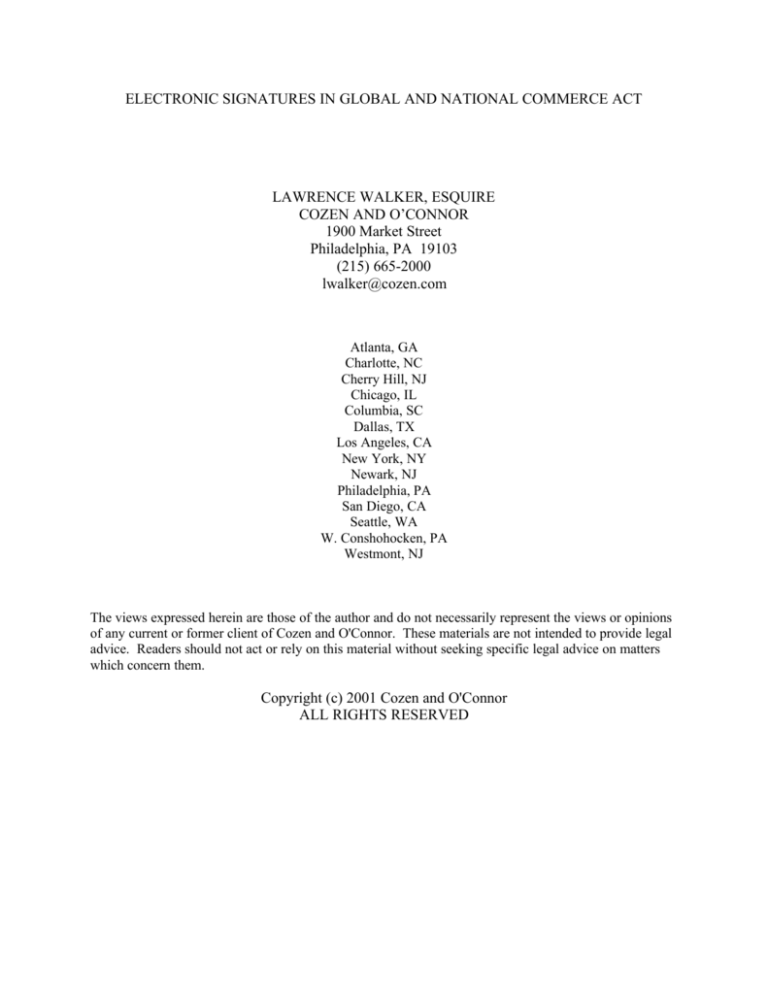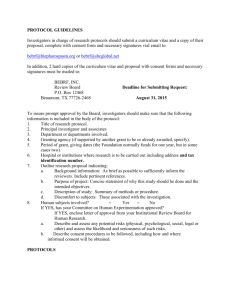
ELECTRONIC SIGNATURES IN GLOBAL AND NATIONAL COMMERCE ACT
LAWRENCE WALKER, ESQUIRE
COZEN AND O’CONNOR
1900 Market Street
Philadelphia, PA 19103
(215) 665-2000
lwalker@cozen.com
Atlanta, GA
Charlotte, NC
Cherry Hill, NJ
Chicago, IL
Columbia, SC
Dallas, TX
Los Angeles, CA
New York, NY
Newark, NJ
Philadelphia, PA
San Diego, CA
Seattle, WA
W. Conshohocken, PA
Westmont, NJ
The views expressed herein are those of the author and do not necessarily represent the views or opinions
of any current or former client of Cozen and O'Connor. These materials are not intended to provide legal
advice. Readers should not act or rely on this material without seeking specific legal advice on matters
which concern them.
Copyright (c) 2001 Cozen and O'Connor
ALL RIGHTS RESERVED
INTRODUCTION
This paper summarizes the Electronic Signatures in Global and National Commerce Act
“the Act” signed into law by President Clinton on June 30, 2000.
BRIEF SUMMARY
The Act encourages electronic commerce by validating the use of electronic signatures,
electronic records, electronic notes, and electronic contracts in any transaction affecting
interstate commerce. Although the records retention provision becomes effective on March 1,
2001, with only a minor exception the remainder of the Act is effective October 1, 2000.
The Act is divided into four Titles:
Commerce; Title II:
Title I: Electronic Records and Signatures in
Transferable Records; Title III: Promotion of International Electronic
Commerce; and Title IV: Commission on Online Child Protection. Each Title will be discussed
in turn.
TITLE I: ELECTRONIC RECORDS AND SIGNATURES IN COMMERCE
Title I of the Act sets forth three basic principals: (1) any transaction utilizing an
electronic signature, contract or other electronic record may not be denied legal effect because it
is in electronic form; (2) the Act does not limit or alter any requirement imposed by law other
than a requirement that a contract or other records be written, signed, or in non-electronic form;
and (3) the Act does not require any person to use or accept electronic records or signatures other
than a governmental agency with respect to a record other than a contract to which it is a party.
S.761, 106th Cong., tit. I § 101 (2000) (enacted). The term “transaction” is defined as action
relating to the conduct of business, consumer, or commercial affairs between two or more
persons, including the sale, lease, exchange, licensing or other disposition of real and personal
property, goods and intangibles, services, and any combination thereof. S.761 tit. I § 106(13). It
was intended to include business, commercial or consumer affairs but not governmental
transactions. Therefore the Act does not cover law enforcement actions, court actions, or the
issuance of government grants and the like. Finally, Title I and II apply to the business of
insurance. S.761 tit. I § 101(i).
There are six topic areas under Title I worthy of discussion: (1) electronic signatures; (2)
electronic records; (3) consumer consent to electronic records; (4) retention of contracts and
records; (5) preemption; and (6) application to federal and state governments.
1.
Electronic Signatures
The Act provides that any transaction utilizing an electronic signature or a contract
signed with an electronic signature may not be denied legal effect solely because it is in
electronic form. S.761 tit. I § 101(a). The term “electronic signature” is defined as a “sound,
symbol, or process, attached to or logically associated with a contract or other record and
executed or adopted by a person with the intent to sign the record.” S.761 tit. I § 106(5).
Significantly, the definition does not identify the method by which parties must electronically
sign the document. Thus, the Act is technology neutral, leaving it to the parties to adopt the
method most suitable for the purpose sought to be achieved.
2.
Electronic Records
The term “electronic record” is defined as “a contract or other record created, generated,
sent, communicated, received, or stored by electronic means.” S.761 tit. I § 106(4). The term
does not include any contract, agreement or record to the extent that it is covered by: (1) a rule of
law governing the creation and execution of wills, codicils or testamentary trusts; (2) a rule of
law governing adoption, divorce, or other matters of family law; (3) the Uniform Commercial
Code as in effect in any state, other than Sections 1-107 and 1-206 and Articles 2 and 2A; (4)
court orders, notices or official court documents (including briefs, pleading and other writings);
or (5) any notice of: (A) cancellation or termination of utility services; (B) default, acceleration,
reposition, foreclosure or other enumerated rights associated with a primary residence of an
individual; (C) cancellation or termination of health or life insurance or other benefits (excluding
annuities); or (D) the recall of a product or material failure of a product that risks endangering
health or safety. S.761 tit. I § 103.
It should be noted that the exclusion pertaining to utility services applies only to essential
customer services such as water, heat and power for example. The provision does not apply to
other broadly used utility services such as telephone, cable television and the like.
Moreover, an oral communication or a recording of an oral communication is not an
electronic record for the purposes of this Act. S.761 tit. I § 101(c)(6). This does not preclude a
consumer from using her voice to sign or approve a record.
Therefore, a record can be
authenticated by voice signature as well as other methods. For example, a voice signature might
be something like, “I Jane Consumer hereby sign and agree to this loan document and notice of
interest charges.” Electronic Signatures in Global and National Commerce Act, 2000: Hearings
on S.761 before the Committee on the Disagreeing Votes, 106th Cong. 2nd Sess. (2000)
(statement of Edward Spencer Abraham, Senator Mich.).
3.
Consumer Consent To Electronic Records
The term “consumer” is defined as “an individual who obtains, through a transaction,
product or services which are used primarily for personal, family, or household purposes, and
also means the legal representative of such an individual.” S.761 tit. I §106(1). It does not
include business-to-business transactions. Thus a business can take full advantage of the
efficiency opportunities presented by this legislation.
Where a statute, regulation, or other rule of law that requires information relating to a
transaction to be provided to a “consumer” in writing, the use of an electronic record may only
be used where the following requirements are met:
(A)
The consumer has consented in a manner that “reasonably demonstrates” that a
consumer can access the information that is the subject of the consent; and the
consumer must not otherwise withdrawn such consent;
(B)
The consumer prior to consenting is provided with a statement:
(i)
Informing the consumer of: (I) an option to have the record on paper; and (II) the
right to withdraw consent and any conditions or consequences associated with the
withdrawal of consent;
(ii)
Informing the consumer of whether the consent applies: (I) only to that particular
transaction; or (II) to an identified category of transactions during the course of
the business relationship;
(iii)
Describing the procedures for withdrawal of consent required in clause (i)
and to update information needed to contact the consumer electronically;
and
(iv)
Informing the consumer: (I) how the consumer may obtain a paper copy of
an electronic record; and (II) whether there is a fee for such a copy.
(C)
A consumer must be provided with a statement of the hardware and software
requirements for accessing electronic records.
(D)
If, after consent, changes in hardware or software requirements create a risk that
the consumer will not be able to access electronic records that the consumer must
be provided with a statement of: (I) the revised hardware and software
requirements; and (II) the right to withdraw consent.
S.761 tit. I § 101(c)(1)(A), (C), (D).
The legislative history of the Act indicates that an e-mail response from a consumer that
confirms that the consumer can access electronic records in the specified format will satisfy the
“reasonable demonstration requirement” mandated by (A) above.
Electronic Signatures in
Global and National Commerce Act, 2000: Hearings on S.761 before the Committee on the
Disagreeing Votes, 106th Cong. 2nd Sess. (2000) (statement of Edward Spencer Abraham,
Senator Mich.).
Additionally, an electronic record, contract or signature cannot be deemed ineffective or
unenforceable solely because the party contracting with a consumer failed to meet the Acts
requirements for consent. S.761 tit. I § 101(c)(3) This provision only affects the records and
simply means that an electronic consent that fails to met the consent requirements of section
101(c) does not create a new basis for invalidating the electronic contract itself.
4.
Retention Of Electronic Records And Contracts
The Act also address statutory and regulatory record retention requirements. S.761 tit. I §
101(d). Where a rule of law requires that a record or contract, including an original record or
contract, be retained, that requirement is satisfied by the retention of an electronic record if three
criteria are met. First, the electronic record must accurately reflect the information set forth in
the contract or other record. S.761 tit. I § 101(d)(1)(A). Second, the electronic record must
remain accessible to all those entitled to access that record. S.761 tit. I § 101(d)(1)(B). Third, the
record must be in a form capable of accurate reproduction for later reference by all parties
entitled to access. S.761 tit. I § 101(e). Reproduction may be by the way of transmission,
printing, or otherwise.
The requirement that a record is capable of accurate reproduction for later reference by
all parties entitled to access is not invoked by the inability of a party to reproduce a record at
some specific moment. This section merely dictates that if a statute requires a contract to be in
writing, the contract should be capable of being retained and accurately reproduced for later
reference by those entitled to retain it. Moreover, an electronic record may be notarized using
the electronic signature of a person authorized to perform such services. S.761 tit. I § 101(g).
Finally, contracts and electronic records relating to a transaction that are formed, created
or delivered by an electronic agent are valid. S.761 tit. I § 101(h). An “electronic agent” is
defined as a computer program or electronic or other automated means used independently to
initiate an action or respond to electronic records or performances in whole or in part without
review or action by an individual at the time of the action or response. S.761 tit. I § 106(4).
5.
Preemption
A state statute, regulation or other rule of law may modify, limit, or supersede the
provisions of Section 101 only if that state action: (1) constitutes an adoption or enactment of the
Uniform Electronic Transitions Act “UETA”; or (2) specifies alternative procedures or
requirements that are both consistent with Title I and Title II of this Act and do not afford greater
legal status or effect to authenticating electronic signatures or records. S.761 tit. I § 102.
Pennsylvania enacted the UETA on December 16, 1999. S.B. 555, 1999 Sess. (Pa. 1999)
(enacted). Thus, this section permits states such as Pennsylvania to opt-out of the federal regime.
S.761 tit. I § 102(a).
6.
Applicability To Federal And State Governments
A federal or state regulatory agency or a self regulatory organization may specify
standards or formats for the filing of records with that agency or organization. S.761 tit. I §
104(a).
This section is limited by the requirement that such agencies comply with the
Government Paperwork Elimination Act (Title XVII Public Law 105-277). However, when
acting as a market participant a federal or state government is exempt from the technology
neutral requirements of the Act. S.761 tit. I § 102(b).
Additionally, a federal or state regulatory agency responsible for rulemaking, may
interpret Section 101 to the extent that such agency is authorized by statute to issue orders or
guidance that is publicly available or published. S.761 tit. I § 104(b)(1). This section grants no
additional or new rulemaking authority to any federal or state agency. The Conference Report
on S.761 requires that any federal agency desiring to issue regulations pursuant to this Act show
conclusively that:
(a) there is a substantial justification for the regulation and the
regulation is necessary to protect an important public interest; (b)
the methods used to carry out that purpose are the least restrictive
alternatives consistent with that purpose; (c) the methods are
substantially equivalent to the requirements imposed on records
that are not electronic records; and (d) such methods will not
impose new costs on the acceptance and use of the electronic
records.
Electronic Signatures in Global and National Commerce Act, 2000: Hearings on S.761 before
the Committee on the Disagreeing Votes, 106th Cong. 2nd Sess. at 15 (2000) (statement of
Edward Spencer Abraham, Senator Mich.).
The Securities Exchange Commission “SEC” is required to issue regulations exempting
from the consent provision certain records concerning a security issued by an investment
company that is registered under the Investment Company Act of 1940. S.761 tit. I § 104(d)(2).
Additionally, the SEC must issue regulations concerning the issuer thereof, to be excluded from
the definition of a prospectus under the Securities Act of 1933. Id.
TITLE II -- TRANSFERABLE RECORDS
This Title recognizes the need to establish a uniform national standard for the creation,
recognition, proliferation and enforcement of electronic negotiable instruments. A “transferable
record” is one that: (A) is a note under Article 3 of the Uniform Commercial Code; (B) the issuer
of the electronic record expressly indicates is a transferable record; and (C) relates to a loan
secured by real property. S.761 tit. II § 201(a)(1). Moreover, a transferable record may be
executed using an electronic signature. Id.
A person is considered to have “control” of a transferable record if a system for
evidencing the transfer of interest in the record reliably establishes “that person,” as “the person”
to whom the transferable record was issued. S.761 tit. I § 201(b). Moreover, a person is deemed
to have control of a transferable record, if the record is created, stored, and assigned in a manner
that: (1) only a single, unique, and unalterable copy exists; (2) the authoritative copy identifies
the person asserting control as the person to whom the record was issued, or if the authoritative
copy was transferred, the person to whom the record was recently transferred; (3) the copy is
communicated and maintained by the person or custodian in control; (4) copies or revisions that
change the identified assignee of the original can be made only with the consent of the person
asserting control; (5) each copy of the original and any copy of a copy must be readily
identifiable as such; and (6) any revision of the authoritative copy is readily identifiable as
authorized or unauthorized. S.761 tit. I § 201(c).
A person in control of a transferable record has the same rights and defenses as a holder
of an equivalent record or writing under the Uniform Commercial Code. S.761 tit. II § 201(d).
Additionally, if certain prerequisites are satisfied the holder of such record shall have the same
rights and defenses of a holder in due course or a purchaser, respectively. Id. Finally, proof of
control of a transferable document as provided under section 201(f) may include access to the
authoritative copy of the transferable record and related business records sufficient to review the
terms of the transferable record and to establish the identity of the person having control of the
transferable record. S.761 tit. II § 201(f).
TITLE III -- PROMOTION OF INTERNATIONAL ELECTRONIC COMMERCE
Title III directs the Secretary of Commerce to promote the acceptance and use of
electronic signatures in international commerce pursuant to the following principals: (1) removal
of paper-based obstacles to electronic transactions; (2) parties to a commercial transaction should
be able to choose the appropriate authentication technologies and implementation models for
their transactions; (3) parties to a transaction should have the opportunity to prove in court or
other proceedings that their authentication procedures are valid; and (4) take a nondiscriminatory
approach to electronic signatures and authentication methods from other jurisdictions. S.761 tit.
III § 301(a)(2).
TITLE IV -- COMMISSION ON ONLINE CHILD PROTECTION
Congress attached an amendment to the Child Online Protection Act (47 U.S.C. 231) to
this Act. Title IV, therefore, is unrelated to electronic signatures in commerce and therefore will
not be further discussed.
PHILA1\1421744\1 099995.000








